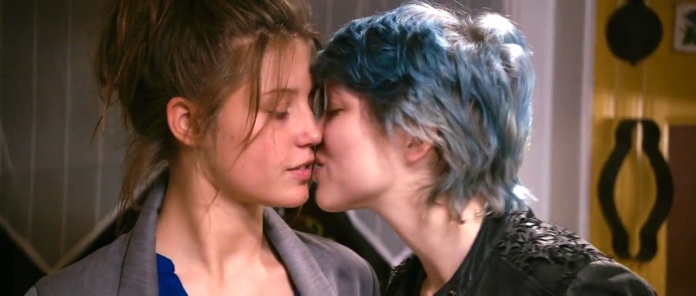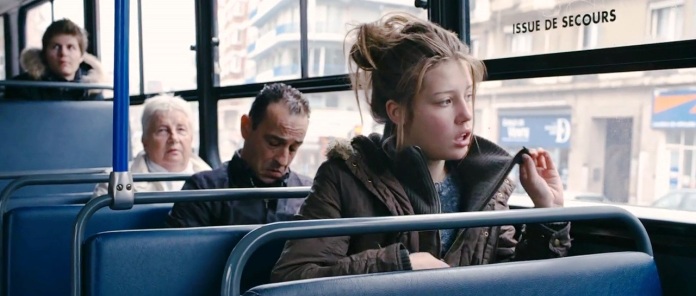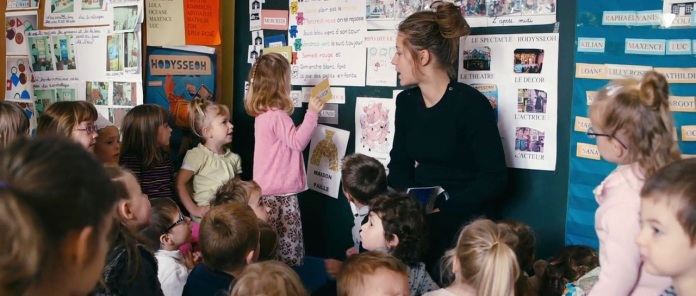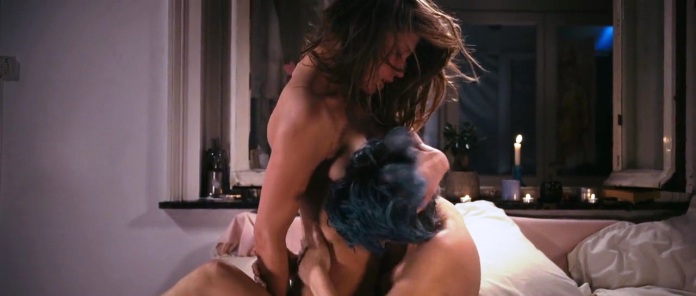La Vie d’Adèle, Chapitre 1 et 2
.

.
Director/Screenwriter: Abdellatif Kechiche
By Roderick Heath
French-Tunisian filmmaker Abdellatif Kechiche specialises in long, leisurely, encompassing behavioral studies of individual humans standing at various crossroads. They are often tilted towards Kechiche’s own understanding of cross-cultural neutral zones and the immigrant experience, whilst also often fluently examining the peculiar rituals and experiences that mark youth’s coming of age. Kechiche’s superlative 2007 epic The Secret of the Grain (aka Couscous), his third film and one of the best of the early millennium, depicted an extended and volatile family working to remake its fortunes by starting a small business. Blue Is the Warmest Colour, his latest, gained a Palme d’Or this year and international fame and notoriety along with it. It clearly extends Kechiche’s oeuvre in encompassing niches of the modern human experience, locating both what’s peculiar and universal about them.
.

.
Based on a graphic novel by Julie Maroh, Blue is the Warmest Colour charts young love, from individual yearning to electric attraction to coupling to break-up, as experienced by and between two young women. Maroh’s book told a familiar variety of queer love narrative with the expected beats of the genre (variably accepting parents, schoolyard angst, etc.) but in a dynamically expressive and highly emotional fashion. Kechiche’s approach is superficially cooler and more exacting, but ultimately travels into the tactile and emotional envelope that forms around its central couple, picking up manifold nuances and peculiarities.
.

.
Kechiche’s narrative replicates both the essence and specific moments from Maroh’s book, whilst revising many elements in a filmmaking process that often seems to have followed its own logic. The film loses the melodramatic bookending narrative and changes the main character’s name from Clementine to Adèle, partly, it seems, to clear a space of independence and to foster lead actress Adèle Exarchopoulos’ stake in the characterisation, and also to justify some shifts in attitude. Kechiche’s style has more than a hint of the neorealist hue revised and updated by filmmakers like the Dardennes brothers and Ken Loach in contemporary European film, except that Kechiche’s touch is more spacious, colourful, and carefully rhythmic, with an almost musical quality (musical performance is usually an important aspect of his work). His stories are less case studies than biographies, a lens that gives the film’s French title its justification, a title that also calls out to the film’s many references to classic French literature.
.

.
Much of Maroh’s book was rendered in a near-monochrome with only striking blues elucidated, reflecting the impact the woolly mane of dyed hair Clementine’s lady love Emma sports in an otherwise drab and petty environment. Kechiche avoids this flourish, painting rather in crisp but painterly colours and sunny hues, with the only suggestion of blue right at the end. But the relationship of film to other art forms, like literature, art, and music, is evoked with a nudging constancy, almost echoing the central relationship in its simultaneous rich accord and subtle disparity. Kechiche emphasises the hidden artifice of dramatic shaping in a manner reminiscent of some other French films, like Philippe Claudel’s I’ve Loved You So Long (2008), including virtually self-deconstructing, essayistic-flavoured passages.
.

.
Such reflexes are readily on display in long scenes in which bored teens in a class read and discuss Marivaux and Sophocles, failing to comprehend the urgency of the relationship between the experiences recorded in art and their oncoming plunge into life, or a later scene in which a middle-aged aesthete may stand in for Kechiche himself in meditating on the overwhelming urge recorded in art history of men trying to comprehend female sexuality. Kechiche calls out to his earlier work in this manner, like his second film, Games of Love and Chance (2003), which was built around rude and rugged high schoolers acting out Marivaux, explicitly testing the relationship of the young products of shifting cultural paradigms with the French canon, finding both alienation and connection through it. Adèle and Emma, whose studies necessarily entail comprehension of technique and representation, are glimpsed at one point exploring an art museum’s sculpture collection. Its rooms filled with roiling nude female forms coaxed into dazzling life from crude ore is an act that Emma—and through her Kechiche—can surely thrill to, whilst for Adèle it’s a way of familiarising herself with the form that very shortly she’ll be exploring more immediately. Young Adèle is a fairly “normal” high schooler who begins to feel the elusive tension between her personal emotions and the pack life that dominates at that age as her friends call her attention to Thomas (Jérémie Laheurte), who’s taken with her, in the school cafeteria. Adèle dates Thomas and has sex with him, but is haunted by the vision of Emma (Léa Seydoux), an older art student she catches sight of with an arm around another woman, the image of her invading her nightly masturbatory fantasies.
.

.
Adèle’s intimation of an almost predestined link to Emma seems borne out when she and gay pal Valentin (Sandor Funtek) venture into gay bars, and Adèle, after having several women hit on her, is rescued by Emma’s charming attentions, setting the scene for a quickly combusting relationship. Adèle and Emma form a bond initially through extended conversations, where attraction and developing mutual confidence grow amidst the thrust and parry of conversation of two smart but callow lasses seeking to justify and express their tastes. Kechiche all but bends over backwards trying to situate his narrative in the great French romantic tradition, with all its references—Les Liaisons Dangereuses is also shouted out to at one point, evoking its rakish delight in bedroom matters and foreboding a later turn in the plot—and his film’s evident echoes. Adèle and Emma’s long, garrulous conversations laced with probing intimations of character and perspective echo the famous bedroom scene of Breathless (1960) and the chatty works of Eric Rohmer and Jean Eustache, whose The Mother and the Whore (1973) anticipates Blue particularly in length and scope. Like those films, and many in the French cinematic pantheon, the degree of cultural literacy on display is surprisingly high, perhaps to an extent that seems artificial (does the average French teen really enjoy talking about De Laclos?). Some of these conceits have specific overtones: when Emma prods Adèle about her knowledge of art, she answers that she’s only really aware of Picasso, who, of course, had his blue period. Kechiche’s work here, however, is in active dialogue with both cultural context and personal experience, whilst negotiating its own evolving disparities as an adaptation.
.

.
Kechiche dials back much of Maroh’s familiar angst, particularly in contending with homophobia as inward retardant on personal acceptance, avoiding clanger lines like one a parent emits in the novel, “Gay pride again? How much longer are they going to be doing this nonsense?” Not that it’s a bright, rosy, postgender world here: Adèle contends with her school friends who, at the first hint of her homosexuality, roundly turn on her. Whereas in the book Clementine runs away and hides to deal with her shame, the more forthright Adèle gets angry and tries to wallop someone. The way people come out, and the world they come out to, has changed, Kechiche notes. More faithfully reproduced from the novel is a moment in which Adèle has her first real same-sex snog, with the bohemian-styled school pal Béatrice (Alma Jodorowsky), who then resists Adèle’s desire for more: such are the pitfalls of curiosity when it grazes against real and urgent need. Kechiche makes long movies because, like the late Theo Angelopoulos and Nuri Bilge Ceylan, he’s a maximalist who specialises in redistributing the way cinema time is absorbed, with a flow of epiphanies that coalesce into a special brand of storytelling, creating an echoing space around the key drama. Unlike them, however, he’s less a poet than a blend of Victorian realist novelist and sociologist. The Secret of the Grain is still his best film because of the fashion in which it justified its heft in building to a brilliant conclusion, one that managed to express simultaneously an urge towards a climactic revelry associated with Shakespearean comedy whilst also counterpointing a tragedy laced with microcosmic import.
.

.
Blue is the Warmest Colour, by contrast, has little story and tones down sociological pressure on its heroines. Kechiche concentrates on the transitory beauties and pitfalls of a relationship that’s based more on a preternatural sexual chemistry than genuine accord of personality, and traces the urges that first brings them together, as Emma helps to ease Adèle through the pains of accepting herself, and then tears them apart, as they grow into distinctively different adults. Emma’s outlook is intimately bound up with her ambitions as an artist, whilst Adèle becomes a teacher of young children. A pair of well-contrasted scenes depicts each girl meeting the other’s family and comprehending the subtle but daunting differences in outlook they face. Emma’s mother and stepfather, casually accepting of her, are haute bourgeois, complete with a fancy art collection started by Emma’s father. In perhaps the film’s most obvious thematic joke, the stepfather, an expert gourmand, serves up live oysters to the girls. The poetic conceit of conflating eating oysters with cunnilingus is not at all new, calling back to, amongst others, Radley Metzger’s film of Violette Leduc’s signal lesbian erotica novel Thérèse and Isabelle (1967), and also suggesting the infamous “snails and oysters” scene restored to Spartacus (1960), whose director, Stanley Kubrick, Adèle loves. Dinner with Adèle’s petit bourgeois family, by contrast, eats spaghetti bolognaise and careful evasion of Adèle’s sexuality; Emma scarcely bats an eye at posing as Adèle’s friend and tutor in philosophy, whilst Adèle’s father (Aurélien Recoing) gruffly grills Emma about her job prospects as an art student, all familiar reflexes of a more working class mindset.
.

.
The quiet disparities outlined in these paired scenes include the first time in the film that both Emma and Adèle state what they want to be. Emma is forced to lie doubly not only about what she is, but also that she fully intends to be an artist, whilst Adèle is honest, but sets the scene for her later frustrations. Adèle remains closeted in some peculiar ways, neither coming out to her parents, or at least not on screen, nor to any colleagues when she becomes a teacher, to protect her brittle sense of security as much as out of concern of what might happen to her. Blue is the Warmest Colour is at its best when charting Adèle and Emma’s coming together, a process that climaxes in the already legendary and notorious central sex scene that sees the couple conjoin in feverishly energetic, invasively corporeal manner. Kechiche counterpoints the convulsive intimacy of the moment with one of public display, as Adèle joins Emma in a gay pride march where the ecstasy of being young and in love loses all bindings for a moment, a scene that mirrors another earlier in the film in which Adèle marches with students. One peculiarity of gay sex scenes in modern film is that they’re just about the only ones where anyone’s allowed to look like they’re actually enjoying themselves (straight sex scenes now, by contrast, are generally required to be hideous). Kechiche mimics Maroh’s approach to Adèle and Emma’s first bedroom encounter, using jump cuts like comic panel boundaries to fragment the girls’ roundelay of positions into an explosive succession of erotic images.
.

.
Kechiche’s approach here is quite clearly unitary with his general fascination for detail and descriptive comprehension, gazing calmly at intense sexual activity as he does at other behavioural traits. But to a certain extent, it also unbalances the film’s emphasis on interpersonal passion and distorts the impression we should be getting, of a young and inexpert girl’s first bedroom romp with a more experienced lover: the necessary sense of exploration is missing. It looks and feels more like an extremely hot one-night stand for two well-practiced sexual athletes, as they whip between positions and smack each other’s asses in search of ever-sharper corporeal registers. The aspect of clinical display is emphasised by the flat lighting and diorama-like bed, carefully charting possible positions and forms, coming close at points to resembling a yoga instruction sheet or “baby’s first pop-up book” of sapphic sex. Other points, however, strike notes of extraordinary beauty, as when the two lie together in symmetrical post-coital calm, as close to a unified creature with two minds as humans can get, the linchpin of both their affair and the film’s aesthetics.
.

.
When gay-themed works like Beginners and The Kids are All Right (both 2010) are so cosily mainstream and sentimental in their reflexes that it’s not too hard to imagine classic Hollywood actors playing roles in them, Kechiche’s gambit to wield an unblinking directness in his sex scenes gives the film a radical edge it wouldn’t have otherwise because he is working with two of the most pleasing possible avatars for lesbian love conceivable. In spite of Emma’s jokes about bull dykes and Adèle’s classmates branding Emma as an obvious lesbian, it’s hard to imagine just about anyone not falling for Emma, whose tousled tomboyishness and anime hair in no way violates rules of attractiveness; ironically, only later, when Emma is older and no longer dyes her hair, does Seydoux seem more genuinely androgynous.
.

.
In terms of the film’s intrinsic personality, two subsequent sex scenes are more impressive. One sees Emma trying to keep Adèle from crying out as they secretly make love in her parents’ house. The other depicts the two lovers, locked in a scissoring tussle, reach out for each other to grip hands, in part for greater traction and pleasure, but as much in that blindly desperate joy of trying to bridge the gap of mere flesh even as it seems they might literally meld. Perhaps indeed the most profound and universal note the film strikes is implicit here, the intensity some relationships can reach on the sexual level, to extent that when other circumstances intrude upon them, it can feel like being cut off from a part of one’s own flesh. Blue Is the Warmest Colour’s second “chapter” deals exactly with this notion as it skips forward a number of years. Now Emma and Adèle live together. Adèle has fulfilled her desire to teach young children, whilst Emma is poised frustratingly close to major success, a success Adèle helps to foster by posing for a lushly semi-abstract nude, exciting the attention of a major gallery manager, Joachim (Stéphane Mercoyrol), who comes to a party Adèle helps to throw. Adèle impresses and charms many present, including Joachim and Samir (Salim Kechiouche), a mildly successful actor who wryly comments on his moment of success, playing an Arab terrorist in an American movie. But Adèle still quietly chafes in their company, especially as Emma tries to talk up Adèle’s diary writing as an accomplishment, an attempt to paper over Adèle’s inferiority in their relationship.
.

.
Adèle is also perturbed by Emma’s friendliness with Joachim’s very pregnant artist friend Lise (Mona Walravens), and as Emma and Lise begin working on a project together, Adèle’s increasing alienation leads her to commence an affair with co-worker Antoine (Benjamin Siksou). Most of this is synthesised from the scant material in Maroh’s book, and begins to smack of a lack of inspiration on Kechiche’s part, as the once-powerful relationship cracks up over such clichéd tensions, with Adèle stuck playing the wife to the mercurial artist in a very familiar kind of domestic drama. The early shout-out to Picasso can be read as a warning that like old Pablo, Emma paints mistresses and moves on. Perhaps this was the point, to show their relationship is prone to the same weaknesses as any other union, but the price Kechiche pays for normalising that relationship is to also make his own narrative more banal, recalling Gus Van Sant’s Milk (2008), which for the sake of mainstream recognition, turned Harvey Milk’s lover into a regulation politician’s stymied wife. Without the force of a strong story behind the film, like The Secret of the Grain possessed, this film’s unwieldy length starts to wear thin.
.

.
Tellingly, the film’s intellectual discursions feel far too academic and potted, relating only to the film’s own telling but without real penetration. Unlike, say, Eustache’s The Mother and the Whore, which is as much about the sociopolitical milieu that formed it as it is about its central ménage à trois, Kechiche deletes most of Maroh’s emphasis on the experience of her couple as products of the early ’90s, when gay visibility was on the rise in a still-reactionary society, and thus of the schism of personality the women experience in the way their sexuality links them to the world. Neither Emma nor Adèle are granted much self-awareness in this regard, in part possibly because in altering the setting to be more contemporary, the relatively laggard sensibility of a more liberated generation is evoked. Whereas Metzger’s Thérèse and Isabelle was intimately layered to both build to the climactic sexual consummation whilst also mediating it through flashbacks to make it both immediate and nostalgic, cinematic and literary, Kechiche’s touch is often much more prosaic.
.

.
Which is not to say he doesn’t wield some marvellous cinematic prose, like that aforementioned image of the entwined lovers and an early sequence in which his camera glides ahead of Adèle after she’s brushed off by Béatrice, her hurt all too vivid even as she maintains a stoic mask and ignores the world whirling about her. Kechiche determinedly avoids melodrama: only the calamitous spat between the couple that breaks them apart resembles a traditional climax, and he skirts several key scenes of the novel, especially the slip-up that sees Adèle ejected from her home and previous life. Moreover, for a film that expends so much time on merely detailing the characters in a love affair, the inner life of both women remains a little vague—in the case of Emma, more than a little. She’s a cagey creature who holds Adèle at a slight remove that Adèle eventually tries to shatter, but this element remains frustratingly opaque. In Maroh’s book, the relationship commences under a pall as Emma already has a girlfriend, which lends a hypocritical edge to Emma’s explosive rage when she throws Adèle out after learning of her affair. Here, however, it seems at once more righteous and also more peculiar in its contextless vehemency. Adèle, for her part, becomes a Lady of Shalott figure, doomed to grieve over her ejection perhaps all her days.
.

.
Kechiche pulls off two excellent scenes as he skips forward again in time: Emma now lives with Lise and her young son as a family, but Adèle, having suffered for a long time, tries hopelessly to entice Emma back when they meet at last for an amicable drink. Adèle’s efforts to seduce Emma reveal once more the powerful spark of physical attraction between them, but can’t break Emma’s new commitment. It’s a somewhat gruelling scene of humiliation for Adèle, reminiscent to my mind of Bob Dylan’s angry heartbreak under surface goodwill in “If You See Her, Say Hello”. The subsequent, ultimate scene, is equally strong, as Adèle attends a gallery showing being given by Antoine signalling Emma’s success, with Adèle finding her portrait hanging with the others, a white-hot and life-changing affair now a mere incident in Emma’s life. Emma and Lise canoodle in the moment of triumph whilst Adèle roams in disquiet. Her intent is all too painfully obvious, as she’s dressed in blue, evidently trying to sway Emma’s eye or at least memorialise their connection. Where for the artist, alchemic creation is the act, for the average person the self is the canvas, and Adèle cannot channel but only telegraph her own bleeding emotion. Adèle meets Samir again, who’s now quit acting for a life in real estate. He searches for her when she quietly absents herself, dashing in a different direction whilst she walks away, a blotch of forlorn blue burning in a grey city street. If the use of the artistic milieu elsewhere feels hoary, here Kechiche uses it to concisely reflect Adèle’s exile: it’s a world of insiders and outsiders, and Adèle is just another outsider now.

It’s a wonderful movie. Adèle Exarchopoulos? Amazing. I disagree with some parts, but the writing is powerful. Congratulations, Rod
LikeLike
Vive la différence, André, but by any measure Exarchopoulos is indeed bloody good. I can’t wait to see her wasted in a big Hollywood movie soon.
LikeLike
“Blue is the Warmest Colour, by contrast, has little story and tones down sociological pressure on its heroines. Kechiche concentrates on the transitory beauties and pitfalls of a relationship that’s based more on a preternatural sexual chemistry than genuine accord of personality, and traces the urges that first brings them together, as Emma helps to ease Adèle through the pains of accepting herself, and then tears them apart, as they grow into distinctively different adults.”
Superlative observation. You have really taken the magnifying glass to this extraordinary film, one that presently (with barely two weeks to go) rates among my own top five films of 2013 with 12 YEARS A SLAVE, SHORT TERM 12, the Italian film THE GREAT BEAUTY and TO THE WONDER.
I am most familiar with Metzger’s work, and applaud you on your thematic connection to the lesbian erotica incorporated in some of the works. Ms. Exarchopoulos delivers a sensational turn and the film is riveting despite the length.
LikeLike
Hi Sam and thanks for commenting. Yeah, I wasn’t hugely impressed by this film, although it certainly has exceptional qualities; as well as, for me, its failing to live up to my expectations of Kechiche after The Secret of the Grain, I’m starting to wonder if, judging by many reactions, this isn’t one of those films that divides people along lines of their emotional commitment to a film: it aims for the heart in spite of its pretences to aiming for the head. Although it certainly got me thinking back to, er, my own busted romances, and it’s surely an incursively intelligent and humane film. We certainly, too, have some shared films in our top film lists, Sam.
LikeLike